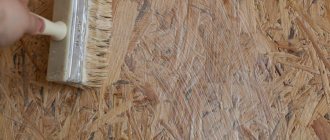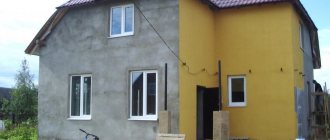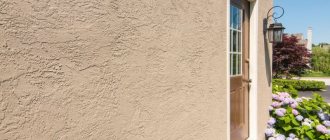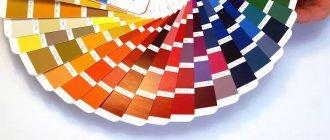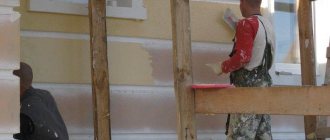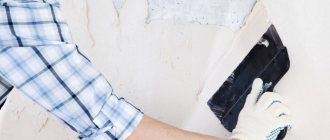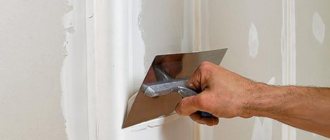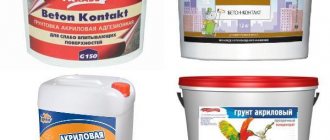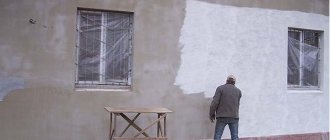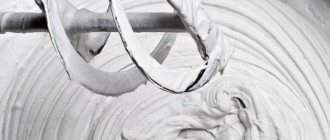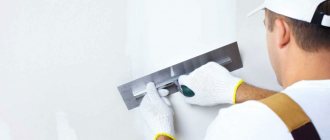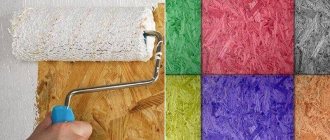Facade putties are construction mixtures specially designed for creating optimally smooth surfaces and subsequent application of the final decorative finishing layer. The terms putty and putty combine one concept and are of German origin, so both designations may appear in different sources. The task of high-quality putty is not only to level the surface, but also to maximize the protection of external walls from the negative effects of external factors.
DIY façade putty
Classification by purpose
Fine-dispersed facade finishing materials, depending on their purpose, can be represented by compositions of different size fractions and consistencies:
- starting putty, better known as a base or leveling mixture;
- the finishing version of a fine-grained putty with a relatively liquid consistency;
- a decorative version of putty that allows you to create textured decorative elements;
- wood putty used to level and protect wooden surfaces.
Depending on the intensity of exposure to external factors, not only the compositions, but also the technical characteristics of facade putty mixtures can vary. A high-quality putty must be vapor-permeable, moisture-resistant, frost-resistant and sufficiently elastic, which will allow the work to be completed by applying paint, decorative tiles, enamels, mosaics or other finishing materials.
Putties differ in composition and characteristics
The base and finishing mixture can be waterproof, frost-resistant and heat-resistant:
- mixtures with water-repellent qualities minimize the risk of condensation appearing on the surface, which can occur under the influence of rain and evaporation. This putty is distinguished by its simple and quick application, uniform distribution, and compatibility with other types of finishing materials;
- frost-resistant mixtures are used when sealing cracks or chips, and increase the resistance of the surface to low-temperature conditions;
- heat-resistant compounds combine excellent adhesive properties and have proven themselves when treating surfaces exposed to high temperatures.
Putties not only hide unevenness, but also perform protective functions for the facade
Using putty - photo
Expert Experience
According to many construction companies, the best putty option for building facades is one that contains cement. This material is quite easy to apply to the surface of the walls and has high strength after drying. If you are going to repair the facade, then you need to understand that each subsequent layer must be more vapor-tight than the previous one. Otherwise, fungus and mold cannot be avoided. So that you don’t have to worry too much about selecting each layer, choose all the elements from the same manufacturer. This guarantees you compliance with the principle of vapor permeability when finishing the facade. This way you can completely protect yourself from incompatibility of materials.
Happy finishing! Share your comments and experiences with façade putty.
Similar articles
- Features of using facade plaster according to...
Why is
a plaster
mesh needed and how to install it.
Some “craftsmen” advise plastering the facade
directly on the foam... Read more - Front fur coat
...it is worth considering that the granularity of the solution will directly depend on the amount
of putty
in it.
...
Universal technology
for plastering facades
using insulation. Read more - Bark beetle plaster on the facade
The plaster
contains acrylic or silicone, which gives the mixture special plasticity.
...
What to do next after
plastering
façade
walls . Read more - Finishing the facade of a house made of aerated concrete blocks
Finishing
aerated concrete
facade with plaster
mixtures.
...
Note that you can add the color of the required shade to
the putty
at the stage of its preparation. Read more - Facade plaster: features and types
For this purpose, for example,
plaster
or
putty ...
Decorative
facade
plaster is sold in a variety of colors. Read more - Finishing the facade with cement bonded particle boards (CSP)
Facade
of a private house.
Finishing the facade
with cement-bonded particle boards (CSB).
...
After
the putty
has dried, you will need to remove roughness from ... Read more
Classification by composition
Each putty mixture is characterized by a composition strictly established by production technology, the main component of which allows us to distinguish several varieties that have certain advantages and disadvantages.
| View | Application | Advantages | Flaws |
Cement | Concrete surfaces with deep cracks. Starting, universal and finishing versions are available, differing in additives. | Resistance to temperature changes, affordable price, ease of work. | Shrinkage occurs and cracking of the layer may occur. |
| Acrylic | The liquid version levels and decorates the surface. Apply with a thickness of 0.1-0.3 cm onto a previously properly prepared and primed surface. | Good moisture-resistant material with a high level of strength and elasticity. | Not suitable for quickly repairing deep cracks; grinding requires the use of a respirator. |
Latex | The paste-like composition has improved moisture resistance and good frost resistance. | Ease of use, high level of plasticity and good protective qualities, durability. | Not very affordable price. |
| Silicate | A mineral version of a façade mixture based on liquid glass, produced in a ready-to-use form. Suitable for working on surfaces consisting of shell rock and cellular concrete. | High vapor permeability, serves as protection against moisture and dust, and has neutral electrostatic characteristics. | A minimal violation of the application technology can cause cracks to appear. |
Oil-adhesive | A high level of density of the composition may affect the uniformity of the applied layer, so certain skills in finishing work are required. | A budget option with high protective properties. | Significant mass and high density, inconvenient application on vertical surfaces. |
| Plaster | The presence of polystyrene in the composition indicates frost resistance, and latex additives improve water-repellent properties. The mixture can be presented in powder and liquid versions. | Durable and plastic material with an affordable price and excellent technical characteristics. | There are practically no downsides when using high-quality material from official manufacturers. |
| Silicone | Elastic material with high vapor transmission and strength. Apply in a thin and uniform layer. | Plastic and vapor-permeable composition in a variety of colors. | The cost is too high. |
Ceresit CT 225. Finishing putty for external and internal work
The best formulations from reliable manufacturers
The following is a brief description of the products offered by the major putty manufacturers.
Putty "Prospectors"
This brand (manufactured by the domestic enterprise of the same name) is a budget brand, and in terms of its consumer characteristics it is certainly worthy. White cement acts as a binding element. The domestic product is easy to use; you can knead and apply it to the wall quickly and effortlessly. Also, the “Starateli” brand product adheres well to the surface. To finish one meter of wall surface, on average, one kilogram of this product will be required, provided that the resulting layer is one millimeter thick.
The material is available in craft bags weighing five and twenty kilograms. This is a very inexpensive product, its cost in stores ranges from 400 to 450 rubles per kilo.
Putty "Knauf"
The price of this product is significantly higher than that of the “Starateli” brand putty. At the same time, it also significantly surpasses the previous product in strength. Another plus of Knauf is its very significant plasticity. This product is applied effortlessly to the surface.
After the putty layer dries, a dense layer forms on the wall, and this coating does not shrink in the future. Also, this brand does not crumble or crack. In addition, Knauf is excellent for grinding.
The range of this manufacturer includes cement and polymer putty. The cost of 25 kilos is approximately five thousand rubles.
Ceresit
The basis for the brand's products is gypsum. It is believed that their application to the wall surface should be done when it is dry and warm. Ceresit putty dries in a very short period of time. This is a significant advantage, but there is a downside. As a result, it is recommended to dilute the product little by little and cover the walls faster. Among other advantages of Ceresit, it should be mentioned that the layer on the wall is strong, the coating does not suffer in frosty weather
Scanmix
The manufacturer produces cement-based finishing products. The putty tolerates moisture well, and nothing unpleasant will happen to it in low temperature conditions. Most often, products belonging to this brand are used for starting wall coverings.
"Vetonit"
The brand is comparable in cost to “Prospectors”; it is a very budget option. Among its advantages is the ability to get rid of potholes in the walls, even if their depth is quite significant. Of course, “Vetonit” will fit equally well on any surface. This material dries relatively quickly, moisture does not cause much damage to it.
Scanmix
Scanmix is another brand; this putty is available in both starting and finishing versions. It has excellent moisture resistance, and frosty weather will not cause damage to it. This composition hardens in just 24 hours, and can be used to repair very significant damage to the wall surface.
Volma Standard
This façade putty is produced at the Volgograd Gypsum Plant, hence its name. There are two brands of this and Sokol on the market. These brands are also designed for budget-conscious users, and these inexpensive compounds harden in a short period of time and subsequently do not shrink. The price for a 25 kilo package is 400 rubles.
Weber vetonit LR+
This starting material can be applied in a very thick layer of up to five millimeters. Moreover, after preparation, the product retains its quality for two days. But accordingly, it does not dry too quickly on the wall; this process will take a whole day. In addition, Weber vetonit LR+ has a large grain size and must be prepared correctly to reap all its benefits.
Weber vetonit JS
This material is intended for finishing walls. It can be used with equal success on both walls and ceilings. The finished composition is suitable for use for a long time. The surface is perfectly smooth and even, the product does not crack over time. At the same time, it is worth keeping in mind that this composition is afraid of high humidity. Due to the lack of water resistance, it makes sense to use it in a room with a dry microclimate, preferably one that is well heated.
PROFORM
This is a relatively expensive putty; it is purchased ready-made; it is in liquid form in a plastic bucket. This material is easy to apply to the surface to be treated, as it adheres well to it. After drying, the coating becomes very durable and will remain unchanged for a long time. The cost of one bucket of composition, which weighs 28 kilos, is approximately 1,400 rubles.
Making your own putty
If there is a need to save money on purchasing factory mixtures, it makes sense to prepare the putty yourself:
- To level concrete, relatively flat surfaces, it is recommended to prepare a gypsum-chalk mixture by mixing three parts chalk and part gypsum. With uniform mixing, the bulk ingredients should be gradually poured into a 5% solution based on wood glue. A homemade solution, mixed until smooth, hardens quickly and should be used immediately after preparation;
Gypsum-chalk putty, mixing
- To level a wooden facade, it is advisable to use an oil mixture, in the production of which a couple of kilograms of drying oil and four kilograms of chalk are mixed, with the addition of a quarter kilogram of drier. The mixture brought to a boil must be cooled to room temperature.
What are driers
Drying oil
Construction chalk, calcium carbonate
It should be remembered that the consumption of self-prepared putty will be higher than when applying ready-made factory-produced mixtures.
How to properly putty a façade
Let’s make a reservation right away: there are two ways to putty a facade: manual and machine. The machine is used to work with large volumes to increase the speed of work. For a private home, of course, this is irrelevant. By the time you get used to the machine, the facade will already be finished, and it will take twice as much material as with the manual method.
Therefore, it is advisable to apply the material yourself, using a spatula or grater. Regardless of the method of applying the material, first of all, the base must be prepared: the surface is cleaned of dirt, dust and oil stains, then priming is performed, which is necessary to ensure adhesion of the materials.
The finished putty material is mixed before work. If there are significant defects on the surface, they must first be eliminated by filling the gaps and cracks with putty. After the “patches” are completely dry, a continuous layer of material can be applied. If necessary, apply several layers. To achieve an excellent result, it is recommended to sand the finished surface.
Advice. You should not putty the facade in high humidity or in hot weather, when the surface is very hot - this greatly reduces the quality of the finish. Because the putty takes some time to dry.
Consumption of façade putty per 1m2
To correctly calculate the consumption of facade putty, you need to decide what composition of products you are going to purchase. There are two options:
- Starting and finishing putty.
- Universal putty.
Consumption per 1 m2 of starting and finishing putty
Starting putty is needed to seal cracks and level out small differences. It is impossible to accurately calculate its consumption, since it is necessary to start from the condition of the wall. But to grout a medium crack, you will need a layer of approximately 3-4 mm per square meter. It may not be necessary to cover the entire wall with starting putty, so it makes sense to estimate the area to be putty.
To cover one square meter with a 4 mm layer of starting putty, you will need four kilograms of dry mixture. Usually the dry mixture comes in 20 kg bags.
The consumption of finishing putty per square meter is less than the starting putty. Largely due to preliminary priming of the surface. You can focus on 1 mm.
To cover one square meter with a 1 mm layer of finishing putty, you will need 1.2 kg of dry mixture.
Consumption per 1 m2 of universal putty
The declared consumption of universal putty by manufacturers is lower than the combination of starting and finishing putty separately. Typically, it is 1.5 kg per square meter for a layer of 1 mm. Manufacturers always indicate consumption on the packaging.
How many mm thick layer you need will all depend on the condition of the surface to be coated. Let's focus on the middle layer of 2 mm.
To cover one square meter with a 2 mm layer of universal putty, you will need 3 kg of dry mixture.
It is justified to use universal putty on more or less smooth and crack-free surfaces.
Stages of work execution
It is recommended to finish the façade after the foundation has settled. As a rule, this process lasts about a year. Processing walls requires some effort and effort; you must be fully prepared for the fact that you will have to do at least two layers of mortar to get the desired result.
It will be impossible to get by with just one layer; even a qualified specialist will not be able to cope with such a task. The best temperature for outdoor work is from 9 to 20 ° C, the permissible air humidity should not exceed 80%.
The process of applying putty occurs as follows:
- The surface is cleaned of excess dirt and old finishes.
- A primer is placed on the cleaned surface; it must dry before further operation. It is better to prime the surface in two layers.
- Next, depressions, dents, and cracks are removed. After which the material is allowed to dry.
- The putty is applied evenly to the walls and then carefully leveled. It is better to use two metal spatulas of different sizes and a construction float as available means. It is important to note that façade material must be used in its pure form and should not be mixed with paint or other additives.
- After the first layer of putty has dried, it must be primed in order to improve adhesion to other layers.
- The starting putty is applied layer by layer until the surface of the facade is completely straightened. Each layer is applied only after the previous one has dried.
- At the last stage, finishing putty is laid on top of the base material.
Preparation of working tools
To carry out puttying work, you will need to purchase some tools to make application easier and get the most even, smooth surface:
- a fairly wide brush with soft bristles or a roller, with which the façade surface is primed;
Maklovitz brush
Rollers for priming walls
- a construction mixer or electric drill with an attachment for high-quality mixing of the putty mixture;
Construction mixer
- Several spatulas of different sizes allow you to process large areas of the facade, as well as corners or hard-to-reach areas.
Spatulas
Construction mixer price
Construction mixer
If paint is to be used as the final finishing of the facade, then the surface must be absolutely flat and smooth, so a well-dried layer of putty will need to be rubbed with a special fine-grained mesh.
Mesh for grouting putty
Surface application
During construction work, special attention should be paid to preparing the putty mixture. Because the quality of the work done ultimately depends on it. It is important to take into account the recommendations indicated on the packaging of the material.
- If dry putty is used in the work, it must be diluted in water. Here's how to dilute putty;
- next you will need a special mixer designed for installation and with it you can stir the mixture to the desired consistency;
Dilution with a mixer
- then leave the solution for five minutes, this is done so that the material infuses. Then beat the mixture again;
- Now the putty is ready for its purpose and you can safely get to work.
If you are using a purchased mixture, then also carry out the above-described manipulations before using it. If you have liquid putty, apply it using a spatula.
After the mixture has completely dried, you can check its readiness and begin treating the wall with a diamond mesh.
Starting layer application technology
Starting mixtures are coarser and coarser. They are used for rough finishing of facades and have good adhesion to concrete, lime, brick and other substrates. Allows you to fill seams, deep cracks and other large defects.
Starting putty - what is it for and what is it good for
Depending on the initial state of the facade, the working solution can be applied in a layer of several millimeters or centimeters. It is recommended to apply the starting solution thinly, but in several tiers. In this case, it is possible to obtain a higher quality finish.
Step 1. Cement and gypsum putty compositions are diluted with clean water in the proportion recommended by the manufacturer. Polymer compositions are ready for use and only need to be mixed before application.
Putty solution
Step 2. We take a small amount of working solution onto a construction spatula, and then apply it to the surface with a sweeping and fairly wide movement. During the application process, the spatula must be pressed fairly tightly to the surface at a stable angle of inclination.
Large and small spatula
The photo shows how to correctly put putty on a spatula
Applying putty
Wall putty process
Step 3. Immediately smear all sagging and uneven areas using an empty spatula, and carefully remove excess mixture.
Wall putty
Step 4. After the solution has hardened, we perform thorough grinding, which allows us to get rid of minor defects and makes the surface even and as smooth as possible.
Grinding
Facades with strong unevenness need to be leveled in several steps.
Quickly hardening self-made compositions or solutions diluted from dry ready-made mixtures cannot be stored. They are used as quickly as possible.
What you need to pay attention to when buying putty
In addition to the fact that the material must be resistant to mechanical and atmospheric influences, it must also have other important characteristics. When purchasing a material, it is necessary to take into account the characteristics that affect the appearance of the surface.
Here's what modern plastering materials should have:
- Possibility to mix with pigment compositions to change color. This will make it possible to do without painting the surface, and any mechanical damage to the walls will not be so noticeable.
- Putty consumption per square meter. Consumption usually depends on the thickness of the laid layer and the filler. The smaller the thickness, the more economical the material is.
- The putty must be compatible with any paints and varnishes that are necessarily used in wall decoration.
- The time period for the mixture to harden.
- Plasticity of the material.
How to choose winter façade putty
What are the main properties for winter facade putties - the ability to work at low temperatures and resistance to cracking when drying. For winter, you can use both acrylic and cement putties. But on the manufacturer’s packaging there must be a corresponding entry - “winter series”. Of course, such putties will be a little more expensive than usual, because they have added special construction chemicals that improve setting at low temperatures.
Which façade putty is waterproof?
Cement putty is waterproof. It is used not only for facades, but also for screeding floors and finishing bathtubs in the house. Therefore, it does not require additional polymers and hydrophobic substances, such as gypsum.
Gypsum putty is not at all suitable for facades and can only be used in interiors, and not in wet rooms. Of course, marketers and technologists united and found a way to use it in wet rooms, adding those same water repellents to it.
Does façade putty protect against fungus?
Those façade putties that contain antistatic and antiseptic agents protect. It is better, of course, to treat the effect rather than the cause. And prevent the formation of fungus on the facade. Mold on the facade is always the result of dampness, which for some reason appears and for some reason does not dry out. It is better to think in this direction to exclude the causes of fungus.
Important! Remember that each subsequent layer in the wall structure must be more vapor permeable than the previous one. If this principle is violated, problems with fungus cannot be avoided by any antiseptics. They simply won't cope.
Which façade putty is suitable for painting?
Any. Both acrylic and cement, your choice.
Which façade putty is best for use on plaster?
Any facade putty is suitable for working on a plaster facade. It will be easier to apply acrylic, but it is more expensive than cement. Acrylic is more elastic. Cement is more economical. The choice is yours.
What to do next after plastering the façade walls
Paint, plaster, finish with panels based on insulation, or use the latest technology of a suspended ventilated facade. A curtain façade is cladding with siding, plastic or metal panels, porcelain stoneware, wood or stone panels. In general, after puttingtying the facade, proceed to the design of the exterior.
Features of finishing putty
Main features of applying putty to the wall
The composition of the finishing putty mixtures is represented by fine-grained fractions, due to which the processed structure acquires a smooth and durable structure. Coarse-grained putties based on quartz sand or marble chips can also be used, designed to create a relief and highly decorative texture of the facade.
In recent years, the most popular way to decorate the façade of buildings is to use putty, which is subsequently pigmented with high-quality coloring compounds. Quite often this method is combined with facing work using natural or artificial materials.
Leveling the finishing putty
Finishing putty will improve the quality of subsequent decorative finishing.
Facade putty can be applied not only manually, but also mechanically, using special equipment. The disadvantage of mechanical application is the lack of the most even application.
What are façade putties made of?
Facade putty can be carried out using mixtures with different ingredient compositions. They are produced on the basis of mineral fillers, plasticizers, cement or gypsum, as well as modifying additives. Facade finishing putty must be able to withstand difficult operating conditions, so it is made mainly from glue, with acrylic, latex or cement added in smaller quantities.
If it is necessary to create the most durable facade, you need to use a cement-based mortar. It is resistant to cracking, and its components often contain quartz sand with a fine fraction. Polymer putties can be latex or acrylic. The latter have a base of acrylic and siloxane mixtures. With their help you can create the first and final outer layer.
Main manufacturers
Putties on the domestic construction market can be presented by both foreign and Russian manufacturers. Of particular interest to consumers are mid-price products with high product characteristics.
| Putty | Type | Applied layer | Drying time | Seasonality of work |
| Dry mixture “Plitonit-KF” | Cement | 5 mm | 72 hours | At +5-30°С |
Dry mix “Knauf Multi-Finish” | Cement | 1-5 mm | 24-72 hours | At +10-20°С |
"Ceresit CT-225" | Cement | 1-3 mm | 24 hours | At +5-30°С |
Dry mix “Glims Finish-R” | Cement-polymer | 1-10 mm | 24 hours | At +5°C and above |
Dry mix “Bolars Finish-Super” | Polymer | 0.2-2.0 mm | 2 hours | At +5-30°С |
Pasta "Bolars Empire-facade" | Polymer | 1-5 mm | 24 hours | At +5-35°C |
Pasta “Profi” | Latex | 1-5 mm | 4 hours | At +5°C and above |
Paste “Holzer Festspachtel Elastisch” | Latex | 0.2-3.0 mm | 10 hours | At +10-30°С |
German cement-based Knauf exterior putties are characterized by high levels of frost resistance and moisture resistance, so they will be the best option for finishing the exterior walls of newly constructed buildings and restoring old façade surfaces.
Knauf putties
Finnish acrylic-based putty compositions “Vetonit” are ideal for working with any concrete or wooden bases subject to high humidity levels.
Photo of Vetonit LR putty
Domestic mixtures “Ceresit”, “Starateli” and “Bolars” are distinguished not only by their affordable price, but also by their good quality, and also allow you to obtain a durable coating.
Photo of finishing plaster Prospectors
Prices for popular types of putty
Putties
How to make cement putty with your own hands?
Finishing materials can be purchased at any hardware store. But you can make it yourself. The mixture contains the main components:
- binders - use polymer materials;
- fillers - use means that separate the putty into gypsum, acrylic, cement;
- coloring pigments.
Cement putty made at home allows you to save your budget. To prepare the mixture, use one of two proven recipes:
- Washed quarry (river) sand in an amount of 10 liters is mixed with cement M400-500, PVA glue is added in an amount of 2 liters. The mixture is poured with 5 liters of water and mixed well with a construction mixer. The consistency of the finished mixture should resemble thick sour cream. This putty has increased adhesion.
- PVA glue is mixed with water 1:1, a dry mixture of M400-500 cement mixed with alabaster is added in a 1:1 ratio by weight. The solution is mixed and used immediately after preparation.
To prepare a high-quality mixture, it is recommended to follow a few simple rules so that the result does not disappoint later. To prepare the mixture, use only clean water without impurities, as well as clean containers. The components are selected finely ground, the mixture is thoroughly mixed until a homogeneous composition is obtained. During the mixing process, the proportions are observed. The prepared solution is applied immediately after preparation, as it sets quickly.
Tips for choosing
To choose the right putty mixture, you must adhere to the following recommendations:
- When choosing putty, it is necessary to take into account the type of material that will subsequently be used when cladding the facade. For example, if it will be painted, it is better to buy a ready-made mixture rather than a dry one.
- Before purchasing, the packaging with putty must be opened and carefully inspected. You should not buy products that have debris or hard lumps on the surface.
- When choosing a putty composition, you need to carefully examine its characteristics. The mixture must be moisture and heat resistant so that it can be used outdoors.
Work with putty
The technology of working with the material has its own characteristics. To avoid troubles, a number of nuances in applying the finishing material are taken into account.
If walls with large differences are to be finished, then reinforced mesh is used. It is placed between layers of putty and prevents cracking after drying.
When applying two or more layers, you must wait until the applied layer dries completely. This takes approximately 12 hours. Experts advise treating each layer with a deep penetration primer. This will improve the adhesion between them.
When applying the solution, you need to hold the spatula correctly in your hand. For work, use a regular wide spatula. Align the corners with a special corner tool. When processing the surface, hold the spatula at an angle of 30 degrees to the base of the wall. At the end of the work, it is washed under running water, otherwise the remaining mixture will harden on the surface of the tool.
After leveling the wall and completely drying the finishing layer, the surface is cleaned with abrasive paper or a metal float.
Knowing all these nuances, you can putty the facade yourself without much effort. The cement-based material is not difficult to work with and is easy to work with using simple tools.
